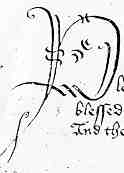


If you are looking at this page without frames, there is more information about medieval writing to be found by going to the home page (framed) or the site map (no frames).
| Petitions (2) | |||
| Access to the king's justice through petition was not restricted to exalted social classes or to the educated clergy. Those who were unable to write their petitions for themselves must have had access to scribes who could produce an appropriately formal and legible hand, and who also knew the acceptable formulae. It is likely that some were penned in the chancery itself by the clerks who knew the system. Certainly most are written in a form of neat document hand that historians refer to as chancery hand and the spelling, although variable, is confined within certain parameters which exclude some regional dialect variations. Petitions which were presented in the chancery court were rewritten by chancery scribes in the correct handwriting, formula and acceptable spelling, and it is most likely these that largely survive in the records. Paleographers may dispute whether such hands were entirely confined to the chancery, or whether there were scribes out in the towns who had the skills to reproduce the same code. | |||
| Segment from a petition of 1440 (National Archives, S.C.9/93/4644). By permission of the National Archives. | |||
| The above sample identifies the petitioners as Nicolas Brempdon, Richard Estdon and William Estdon, staynours, or tin miners. The neat document hand of their petition must have been produced by a professional scribe, either from the chancery or trained in their system. | |||
| Nevertheless, it must not have necessarily been compulsory to follow a prescribed style sheet in order to have access to the system. The following example is written in a very crude and messy hand. Furthermore, the spelling is eccentric even by 15th century standards, and it does not conform to the standard formula. | |||
 |
|||
| This is a segment from a petition (National Archives E.28/76/32) of 1445-6 . By permission of the National Archives. | |||
| The petition above, from one Richard Mountfort, complains that one Thomas Burdette has made several attempts upon his life.It is written in what can only be described as an ordinary cursive hand. There is no address to the king, and no meek beseechings as the document launches into a wordy account of the petitioner's misfortunes. Words have been crossed out and rewritten above in several places. One might imagine a local parish priest with dubious literacy struggling away with this one. But then, one is not supposed to imagine things about historical evidence, is one? | |||
| In general, these documents were not highly decorative, the emphasis being on a neat, legible hand that did not distract from the business under consideration. The only calligraphic extravagance appears to be the occasional production of fanciful and curly capital letters of rather spidery form at the head of the document. |  |
 |
|
| Two elaborate capitals on petitions (National Archives, E.28/60/38 and E.28/79/30). By permission of the National Archives. | |||
| It is also interesting that the script used to annotate the petition in the chancery was generally a cursive of rather different form to the bastarda style which was commonly used for the petition itself. This is not just a case of a different scribe, but probably of a sense of appropriateness of different script styles for different purposes. The bastarda or so-called chancery hand of the body of the petition being a somewhat ceremonial script, while the cursive of the annotation was the honest hardworking business hand of a bureaucrat. | |||
| The end of the petition and the beginning of the annotation in the Christchurch petition which has been featured here (National Archives, E.28/60/38) By permission of the National Archives. | |||
| Petitions were not copied on to rolls in the chancery. The surviving evidence is in the form of thousands of small pieces of parchment, the original petitions themselves, now archived in the National Archives in London. Heaven knows how incomplete the record is, given the propensity for small bits of parchment to lose themselves over the centuries. Nevertheless, they have the potential to provide an important insight into the late medieval legal process. A Tillotson of my acquaintance actually wrote a huge PhD thesis about them, and maybe now that he has retired from teaching undergraduates he might even write a book about them, but I doubt it. | |||
|
|
|||
|
|
|||
|
If you are looking at this page without frames, there is more information about medieval writing to be found by going to the home page (framed) or the site map (no frames). |
|||